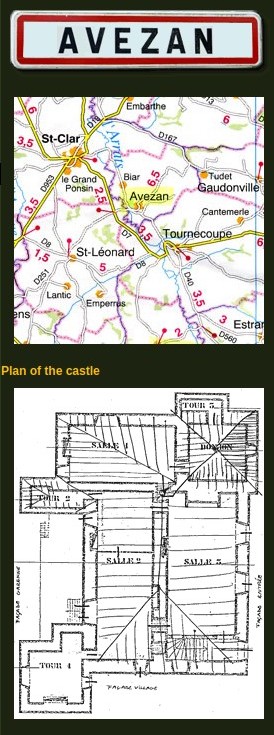
 From atop its hill in the village of the same name, Chateau Avezan watches over the road that leads to the village of St Clar, 4 km away.
From atop its hill in the village of the same name, Chateau Avezan watches over the road that leads to the village of St Clar, 4 km away.
Originally, this castle was probably what is called a salle –a single dungeon with thick walls—resting atop a vaulted hall. Despite successive transformations, it has kept the severe allure of a fortress.
According to Patrice Cournot, “In all probability, however, the dungeon was erected separately during the year 1230 and, towards the end of the thirteenth century, was added a hall whose façade was completely remodeled thereafter.”
It is thought that the castle was constructed by order of the Viscounts of Lomagne. Due to its strategic position and the fact that the seigneurs of Lomagne allied themselves with the English against King Louis IX during the Hundred Years War, Chateau Avezan found itself at the center of many battles for the conquest of the region. This would explain the castle’s impressive size.
This parallelepiped, with its thick walls, middle structure of high quality, hermetically sealed facades, and its proud and aggressive stance, is characteristic of the Gascon chateaux that multiplied throughout the thirteenth and fourteenth centuries.
“In the thirteenth century, the building had no opening, with the exception of loopholes. The only point of access was a high portal, and all that had to be done to ensure its security was to remove the ladder (…)
The dungeon, on the other side, rose much higher than the other chambers. In addition to being a final defensive bastion, it was also a symbol of the seigneur’s power.
The chambers were built right up against the dungeon.
Communication between them and between floors was limited for increased security (…) During the fifteenth century, an attempt was made to aerate the castle and let light in without compromising the defensive system, which was actually improved. Two large moats were dug, which are now filled in (…) and the battlements that encircle the castle date from that era. A walkway goes along their interior, which permitted fighters to quickly reach a point under attack (…)
Finally, another system appears. It consists of corridors or underground tunnels which permitted the defenders to move about quickly without being seen, to counterattack at various points and to give the attacker the impression of a large garrison.”
Patrice Cournot.
During the sixteenth century, the castle endured the first renovations designed to remove its defensive function. Beginning in the seventeenth century, at the time of its purchase by Alexandre de Larroquant, the entire western structure was erected, accompanied by some improvements to the interior which continued into the eighteenth century:
a stairway, living quarters, paintings, fireplaces and bays.
All this remodeling betrays a desire to transform this austere fortress into a pleasant and comfortable abode. The stairway in particular has significantly changed the building’s internal structure and has appreciably improved its comfort by making the apartments, now larger, independent.
“The very number and violence of the lawsuits that were filed to obtain it in the eighteenth century gives the impression that [the castle] had been completely transformed by the Larroquant family, who had made it into a rather coveted abode.” Patrice Cournot.
During the latter half of the eighteenth century, the castle passed through the hands of families who neglected it, and it was bought by tenant farmers after the Revolution. Afterward, it was abandoned. However, it seems not to have lost its importance, judging from the testimony of an admirer in 1861 who presented the ancient fortress as one of the most “respectable in the region.”
Bought by the Cournot family, the castle has been considerably restored since 1972. It is open to the public.
The seigneurs of Avezan
- Les Manas, under the banner of the Viscounts of Lomagne
The first seigneur of Avezan was probably Raymond Sans de Manas, who was given the chateau by his seigneur Othonn Viscount of Lomagne and of Auvillar in exchange for the former’s promise to enter into the latter’s armed service.
In fact, for almost two centuries, Avezan was one of those Gascon chateaux allied with England. As Patrice Cournot writes, “This phenomenon, while shocking for some, was completely understandable. The Gascons, and particularly the viscount of Lomagne and Auvillar –in whose territory the Chateau Avezan stands--, allied themselves systematically with the English side except when the accidents of marriage, succession, a lost battle, an attack or a treaty put them under French administration (…) In any case, they did not have more affinities or common memories with the French than with the English. By the same token, the two camps spoke languages that were for them completely foreign. A French administration or English administration was seen as a government imposed from without (…) Finally, and this is without a doubt the most important point, the Gascons, and the Viscount of Lomagne in particular, who struggled ceaselessly to maintain the independence of their little states, only saw the advantages to recognizing the authority of a king who was far away and across a sea rather than that of a neighboring king established so close to their territory.”
The Manas of Avezan had their apogee with Jean de Manas at the beginning of the fifteenth century.
- The Larroquan family
Alexandre de Larroquan bought Chateau Avezan in 1651.
But, it was his brother Jacques de Larroquan who would become the veritable seigneur of Avezan. “A soldier by trade, he was a brigadier of the king, whose confidence he enjoyed as well as that of Richelieu. It is perhaps to this confidence that the castle’s survival is owed. Indeed, Richelieu ordered a good number of chateaux razed in order to destroy the power of the seigneurs.” Patrice Cournot.
The Larroquan family continued to live at Avezan until the French Revolution.
